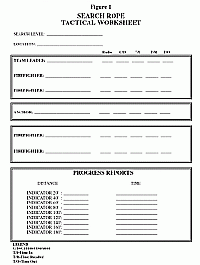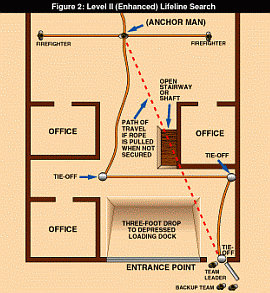Articles
Menu
- Promotional Assessment Centers, Understanding the process
- Lifeline Search: A Systematic Approach
- SCBA Basics
- Yankee Gutters: The Hidden Danger
- Tools For Managing The Incident
- Roof Operations: Listen, Look and Cut
- False Peaks: Help or Hindrance to Firefighting Operations?
- Water Supply: The Operating And Supply Pumper Concept
- The Jersey City Effort
- Size-Up: Updating An Old Acronym
- Jersey City Waterfront Triage
- Fireground Size-Up For Factory and Warehouse Fires
- Fireground Size-Up: Row Frames
- Fireground Size-Up For Garden Apartments And Townhouses
Lifeline Search: A Systematic Approach
Systematic search for life in large-area structures demands well-planned and coordinated efforts. Team lifeline search is not a new concept; it has been used for years. This article presents some innovations to help improve a firefighter`s confidence about groping into the dark and to enhance safety.
Team lifeline search is used when the layout, interior, configuration, or size of the search area requires the extra safety dimension afforded by lifeline assistance. Preincident information gives the best indication of when to use lifeline-assisted search teams in a structure. On-scene size-up and special hazardous circumstances will demand that lifeline search teams be used. A safe and effective lifeline search operation must begin before the alarm is sounded. Preplanning for lifeline search requires identifying the areas in which lifeline searches should be used and your department`s resources.
RESOURCES NEEDED
Pieces of equipment needed to implement the concept are a bag and a rope. We have found that a reinforced nylon bag with a design shape similar to that of a vertical rectangle deployed best.
The rope can be downgraded life safety rope (nylon or kernmantle) or assigned minimum 38-inch diameter approximately 180 feet in length. The rope has within it a simple but innovative “twist” to build firefighter confidence–this twist simply is “consecutive knots.” Consecutive overhand knots are placed in the rope at 20-foot intervals–for example, one knot at 20 feet, two knots at 40 feet, three knots at 60 feet, and so on.
This system gives a search team a bearing on the distance it has traveled, whether entering or exiting the questioned area. Enabling a firefighter to use the sense of touch to gauge the distance traveled helps ease the anxiety associated with searches in dark environments. The decreased anxiety should help team members to operate with a clearer mind so they can meet their objective(s) safely.
Comparison surveys conducted during training evolutions on lifeline search ropes with consecutive knots and those without knots showed that firefighters` physiological fears about crawling into the unknown were quelled when the firefighters were able to “feel” the distance traveled. A simple system, but very effective!
Following are the manpower and equipment requirements, breakdown of search team members` responsibilities, operational procedures, and other pertinent information for conducting a Level 1 Lifeline search and a Level 2 Enhanced Operations search.
LEVEL 1 LIFELINE SEARCH
Suggested manpower for a basic evolution consists of a team leader/officer and four firefighters.
- SEARCH TEAM LEADER

- Tool assignment:
a. portable radio, with designation
b. flashlight (placed at point of entry)
c. clipboard with tactical worksheet (see Figure 1)
d. digital watch/timer (can be mounted on clipboard) - Responsibilities
Monitors:
1. how many people enter
2. who they are
3. entry/on-air time
4. recalls members as per air/time projection
- Tool assignment:
- TWO SEARCH TEAM MEMBERS
- Tool assignment:
a. portable radio, with designation
b. flashlight(s)
c. forcible entry tools: flathead axe, halligan, rabbit tool
d. thermal imaging camera: extremely valuable if available - Responsibilities:
a. Systematic search questioned area: specific area as assigned.
b. Give periodic progress reports to team leader: radio to team leader each knot distance.
- Tool assignment:
- TWO ADDITIONAL SEARCH TEAM MEMBERS
- 1.
Tool assignment:
- a. portable radio, with designation
- b. flashlight(s)
- c. tools to supplement initial team
- 2.
Responsibility:
- a. emergency backup or relief of initial search team.
- Operation
- Search team leader secures end of rope to a stationary object (stationary: fixed, unchanging).
- All members switch radios to a separate fireground channel, exclusively for this operation.
- A large floodlight or flashlight is placed at the entrance and is to be used as a focal point for searches upon exit.
- Search team leader monitors personnel entry and on-air times from the questioned area entrance. (Safety note: On-air penetration/exit times, based on rate of consumption:
- 30-minute cylinders
a. 10-minute penetration
b. 10-minute exit - 60-minute cylinders
a. 20-minute penetration
b. 20-minute exit - At the end of the penetration duration, the team leader must recall the team.)
- 30-minute cylinders
- Search team members: recon team notes/reports:
- heat, smoke, fire behavior/conditions;
- floor construction, layout, stability;
- extension probability;
- any unusual circumstances;
- radio reports from team leader; and
- overall objectives (keep focused).
 Search teams, when possible, are to secure the rope whenever there is a change in the direction of the search pattern. This enhances the safety of exiting and entering members in case the rope is pulled taut during the operation. (See Figure 2.)
Search teams, when possible, are to secure the rope whenever there is a change in the direction of the search pattern. This enhances the safety of exiting and entering members in case the rope is pulled taut during the operation. (See Figure 2.)- All radio communications are controlled through the officer/team leader.
- The operations officers must periodically apprise the officer/team leader of support operations.
LEVEL 2 ENHANCED OPERATIONS
Follow all basic Level 1 steps, but add a secondary team officer/leader. This additional officer can act as an “anchorman”; he would place himself down the search rope at each 20-foot knot interval. From here, team members can deploy out from the anchor with a 20-foot personal rope so as to double the area covered in the limited time. Team members can deploy out together off one side of the anchor, or each can take a side of the anchor to search. The operation can be modified to meet the needs of the department as well as the particular objective.
As we further educate ourselves in incident command and incident priorities as they relate to firefighter safety and accountability, it becomes evident that lifeline search practices can play a vital role in the fire service. Departments using lifeline search should continually train in and educate themselves with regard to the use of this operation; doing this should further quell fears about crawling into the unknown.
